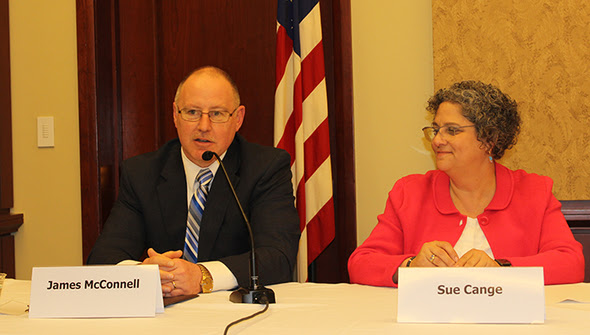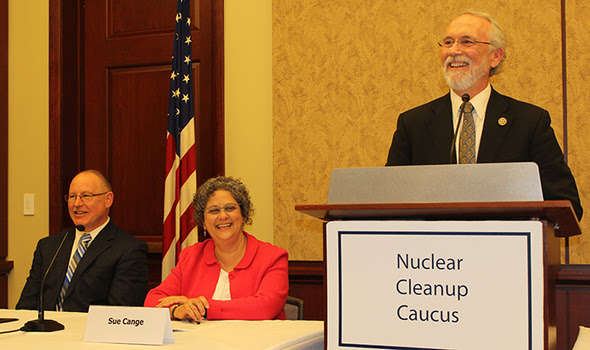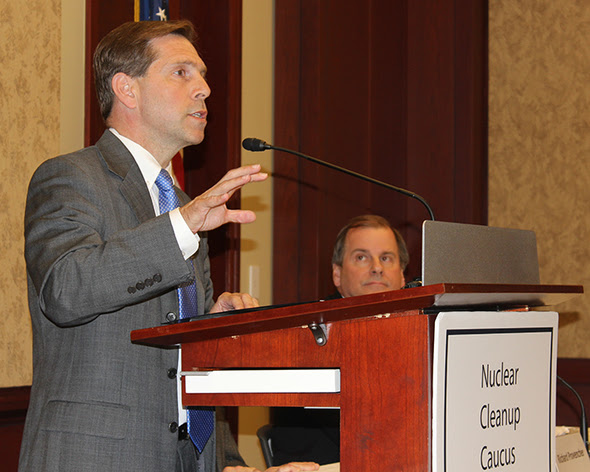
|
EM Update | Vol. 10, Issue 7 | April 13, 2017
|
||
|
||
DOE Highlights Collaborations at House Nuclear Cleanup Caucus
Rep.
Joe Wilson of South Carolina addresses the audience as the four
panelists listen during the event for the House Nuclear Cleanup Caucus.
WASHINGTON, D.C. – Officials with EM and other DOE
missions highlighted their partnerships to clean up sites and manage
and dispose of wastes at an event for the House Nuclear Cleanup Caucus
on April 5.
Speaking to an audience of more than 100 people, Acting EM Assistant
Secretary Sue Cange noted the interconnections between the cleanup
program and other DOE organizations. She said her priority is to improve
collaborations and strengthen those partnerships.
“First and foremost, it is extremely important to recognize the
important and enduring missions the Department has in the areas of
national security, science and nuclear energy,” she said. “It is also
very important to recognize the role the Office of Environmental
Management plays in ensuring and enabling those important Departmental
missions.”

James
McConnell, Associate Administrator for Safety, Infrastructure and
Operations at the National Nuclear Security Administration, speaks
during the panel discussion as Acting EM Assistant Secretary Sue Cange
listens.
The four panelists described a DOE ecosystem in which EM intersects
with a variety of missions, providing valuable site cleanup, technical
expertise on waste management, pathways for waste storage and disposal,
and decontamination and demolition of aging excess facilities.
James McConnell, Associate Administrator for Safety, Infrastructure and Operations at the National Nuclear Security Administration (NNSA), said the agency has broad interactions with EM.
“Our mission, by its very nature, generates some amount of radioactive
and mixed waste, and if we can’t safely stage, store, transport and
ultimately dispose of that waste, then at some point we would have to
stop generating it, which means at some point we would have to
fundamentally stop our mission,” McConnell said.

Acting EM Assistant Secretary Sue Cange discusses EM’s collaborations with other DOE mission.

Johnny
Moore, Manager of the Oak Ridge National Laboratory Site Office in the
Office of Science, right, talks about the Oak Ridge National Laboratory
mission. At left is Rick Provencher, Deputy Assistant Secretary for
Idaho Site Operations in the Office of Nuclear Energy.
“It’s critical that we have those outlets,” added Johnny Moore, Manager of the Oak Ridge National Laboratory Site Office in the Office of Science.
“Those are critical to our mission because if we are going to continue
to learn and make discoveries in doing nuclear research we have to have
the ability to have outlets for those materials.
“EM is needed to perform cleanup work of their facilities and of all
the facilities that we have in our program operations,” Moore said.

Rick
Provencher, Deputy Assistant Secretary for Idaho Site Operations in the
Office of Nuclear Energy, talks about the partnership between EM and
the Office of Nuclear Energy.
Rick Provencher, Deputy Assistant Secretary for Idaho Site Operations in the Office of Nuclear Energy (NE), said EM and NE have enjoyed a productive partnership at the site for more than a decade.
“It’s really been a team sport in Idaho for many years,” Provencher
said. In 2005, EM and NE decided to split the contract for the Idaho
site, allowing the NE-affiliated Idaho National Laboratory to focus on
science while cleanup contractors overseen by EM focused on
remediation.

Rep.
Dan Newhouse of Washington state speaks as panelists James McConnell,
Associate Administrator for Safety, Infrastructure and Operations at the
National Nuclear Security Administration, and Acting EM Assistant
Secretary Sue Cange listen.

Rep. Ben Ray Luján of New Mexico speaks to the audience of more than 100 people.
“EM, they are the experts,” Provencher said. “They have the treatment
systems and the know-how to do that kind of work, and by them doing
that, it allows the laboratory to focus on important research and
development work that we’re responsible for.”
A challenge common to each of the programs is the management and
disposition of excess facilities. A DOE report to Congress in December
counted 2,349 such facilities across the Department complex. An
additional 1,000 may be designated excess in the next 10 years.

Rep. Chuck Fleischmann of Tennessee speaks at the event for the House Nuclear Cleanup Caucus.
Cange previously managed EM operations at Oak Ridge, where NNSA, the
Office of Science and NE each have a significant presence. She used that
site’s collaborative approach to compiling one set of data on excess
facilities across programs as an example of agency partnership.
Rep. Chuck Fleischmann of Tennessee, the caucus chairman, said he was
encouraged by the interactions among the DOE missions.
“It is our duty to the American people to get these sites cleaned up,”
he said. “My commitment is steadfast to see that we get these legacy
sites cleaned up.”
|

No comments:
Post a Comment